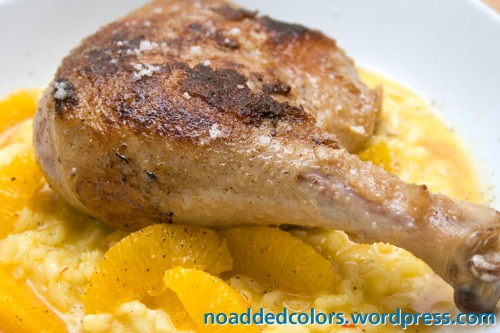
I decided to continue my sous vide experiments. I still don’t have a vacuum sealer and I still don’t have a temperature controlled water bath. The setup was thus equally improvised as last time.
This time, I cooked duck legs instead of steaks. The idea behind this was that duck legs should be more forgiving about temperature. From my previous experiments, I knew that the lowest possible setting of my stove will bring the water to temperatures somewhere above 60 °C. Since this is too hot for a good steak, I had manually switched off the stove from time to time. This time, however, I decided to let it on. And I do now know that water temperature will then lie constantly between 63 and 64 °C. This should be alright for duck legs.
I cooked them for a total of three hours. The result was … well, it wasn’t really bad, but it wasn’t exactly good either. While the muscle parts were done, the connective tissue wasn’t. Obviously, those three hours weren’t enough to break down the collagen. So while the meat was indeed tender, the duck leg as a whole was too chewy. Next time, I will try out five or six hours.
In terms of flavor, the meat was really fine. I chose a classic French style: canard à l’orange. Originally, canard à l’orange is made from a whole duck which is filled with oranges and then cooked in the oven. My version of it was largely inspired by a recipe of Hervé This, published in his 1995 book “Révélations gastronomiques”. I really liked his idea of injecting herb-infused orange liqueur into the meat. However, This’s original recipe suggests microwaving instead of sous vide cooking (which was not common back in 1995). I also made some adjustments to the sauce.
Canard à l’orange – sous vide
Serves 2:
2 duck legs
50 ml orange liqueur (Cointreau or Grand Marnier)
2 thyme sprigs
1 bay leaf
salt
pepper
1 large orange
1 tsp. sugar
100 ml white wine
200 ml chicken stock
2 tblsp. oil
Chop thyme and bay leaf and mix with the liqueur, salt, and pepper. Macerate for 20 minutes, then strain. With a syringe, inject the liqueur into the duck legs. I tried not to puncture the muscle strands, but to distribute the liqueur throughout the connective tissue spaces, i.e. under the skin, along the large vessels and nerves, or even along the bones. Thoroughly massage the duck legs afterwards to distribute the liqueur more evenly. Put each duck leg into a plastic bag of its own, carefully squeeze out any air, and tie a knot to close the bag.
In a large pot, heat water to 60-65 °C. Place the plastic bags into the water. If necessary, use a wire rack to hold the bags under water. Cook for three or more hours.
To fillet the orange, generously cut off the peel, including the white pith. Then cut out the segments. Carefully capture all the juice and squeeze out the remaining membranes.
Melt the sugar in a small pot over moderate heat until golden. Add the white wine, boil down completely. Then add the chicken stock, again boil down to a thick sirup.
Heat the oil in a frying pan. Take the duck legs out of the plastic bags and dab them dry with paper towels. Quickly sear them over high heat from all sides.
In the meantime, add the duck juices from the plastic bags as well as the orange juice to the caramel, bring to boil. Remove from the heat, add the orange fillets, and heat them. Season with salt and pepper.
Arrange orange sauce and duck legs on plates. I served the dish with saffron risotto.
No comments:
Post a Comment